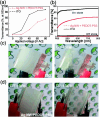A Comprehensive Review on Polymer-Dispersed Liquid Crystals: Mechanisms, Materials, and Applications
- PMID: 39802145
- PMCID: PMC11718547
- DOI: 10.1021/acsmaterialsau.4c00122
A Comprehensive Review on Polymer-Dispersed Liquid Crystals: Mechanisms, Materials, and Applications
Abstract
Polymer-dispersed liquid crystals (PDLCs) stand at the intersection of polymer science and liquid crystal technology, offering a unique blend of optical versatility and mechanical durability. These composite materials are composed of droplets of liquid crystals interspersed in a matrix of polymeric materials, harnessing the optical properties of liquid crystals while benefiting from the structural integrity of polymers. The responsiveness of LCs combined with the mechanical rigidity of polymers make polymer/LC composites-where the polymer network or matrix is used to stabilize and modify the LC phase-extremely important for scientists developing novel adaptive optical devices. PDLCs have garnered significant attention due to their ability to modulate light transmission properties, making them ideal candidates for applications ranging from smart windows and displays to light shutters and privacy filters. The incorporation of different ferroelectric, thermoelectric, magnetic, and ferromagnetic nanoparticles, quantum dots, nanorods, and a variety of dyes in the PDLC matrix has gained momentum over a span of few decades, as it lowers the otherwise-required high operating voltage and reduces the electro-optical response time of these devices. Due to better contrast in the transmittance of these materials in the field-off and on states, they find extensively wide application in a variety of photonic applications, viz., optical shutters and smart windows, photorefractives, modern displays, microlens arrays encompassing polymer-gravel lenses, and many other. Since the functional parameters of these devices embrace the thermophysical attributes of PDLC networks, it therefore becomes necessary to perform a detailed analysis of the properties of PDLCs and their ameliorations upon the addition of different dopants. This Review aims to review the recent advances in PDLCs and their enrichment in terms of their performance parameters upon the addition of a variety of dopants, as well as the improvement of different photonic applications owing to superior parametric implementation of these networks.
© 2024 The Authors. Published by American Chemical Society.
Conflict of interest statement
The authors declare no competing financial interest.
Figures













Similar articles
-
Effects of Multi-Fluorinated Liquid Crystals with High Refractive Index on the Electro-Optical Properties of Polymer-Dispersed Liquid Crystals.Materials (Basel). 2025 Mar 21;18(7):1406. doi: 10.3390/ma18071406. Materials (Basel). 2025. PMID: 40271568 Free PMC article.
-
Preparation of Progressive Driving Bilayer Polymer-Dispersed Liquid Crystals Possessing a PDLC-PVA-PDLC Structure.Molecules. 2024 Jan 19;29(2):508. doi: 10.3390/molecules29020508. Molecules. 2024. PMID: 38276586 Free PMC article.
-
Nanostructured Polymer-Dispersed Liquid Crystals Using a Ferroelectric Smectic A Liquid Crystal.Molecules. 2024 Oct 12;29(20):4837. doi: 10.3390/molecules29204837. Molecules. 2024. PMID: 39459206 Free PMC article.
-
Recent Advances in The Polymer Dispersed Liquid Crystal Composite and Its Applications.Molecules. 2020 Nov 25;25(23):5510. doi: 10.3390/molecules25235510. Molecules. 2020. PMID: 33255525 Free PMC article. Review.
-
Optical microscopy studies of dynamics within individual polymer-dispersed liquid crystal droplets.Acc Chem Res. 2005 Feb;38(2):137-45. doi: 10.1021/ar040106p. Acc Chem Res. 2005. PMID: 15709733 Review.
Cited by
-
Multifaceted Nanocomposites Combining Phosphorylated PVA, MXene, and Cholesteric Liquid Crystal: Design and Application Insights.Nanomaterials (Basel). 2025 Aug 14;15(16):1251. doi: 10.3390/nano15161251. Nanomaterials (Basel). 2025. PMID: 40863831 Free PMC article.
-
Reactive Fluid Ferroelectrics: A Gateway to the Next Generation of Ferroelectric Liquid Crystalline Polymer Networks.Small. 2025 May;21(21):e2501724. doi: 10.1002/smll.202501724. Epub 2025 Apr 7. Small. 2025. PMID: 40190156 Free PMC article.
-
Enhanced Infrared Shielding Function in ATO-Doped Polymer-Dispersed Liquid Crystal Films.Molecules. 2025 Apr 11;30(8):1730. doi: 10.3390/molecules30081730. Molecules. 2025. PMID: 40333711 Free PMC article.
References
-
- Lin Y.-H.; Wang Y.-J.; Reshetnyak V. Liquid crystal lenses with tunable focal length. Liquid Crystals Reviews 2017, 5 (2), 111–143. 10.1080/21680396.2018.1440256. - DOI
-
- Kim T. H.; Kim M.; Manda R.; Lim Y. J.; Cho K. J.; Hee H.; Kang J.-W.; Lee G.-D.; Lee S. H. Flexible Liquid Crystal Displays Using Liquid Crystal-polymer Composite Film and Colorless Polyimide Substrate. Curr. Opt. Photon. 2019, 3 (1), 66–71.
-
- Choi H.-M.; Choi J.-G.; Kim E.-S. Dual-View Three-Dimensional Display Based on Direct-Projection Integral Imaging with Convex Mirror Arrays. Applied Sciences 2019, 9 (8), 1577.10.3390/app9081577. - DOI
-
- Schadt M. D. Nematic liquid crystals and twisted-nematic LCDs. Liq. Cryst. 2015, 42, 646–652. 10.1080/02678292.2015.1021597. - DOI
Publication types
LinkOut - more resources
Full Text Sources
